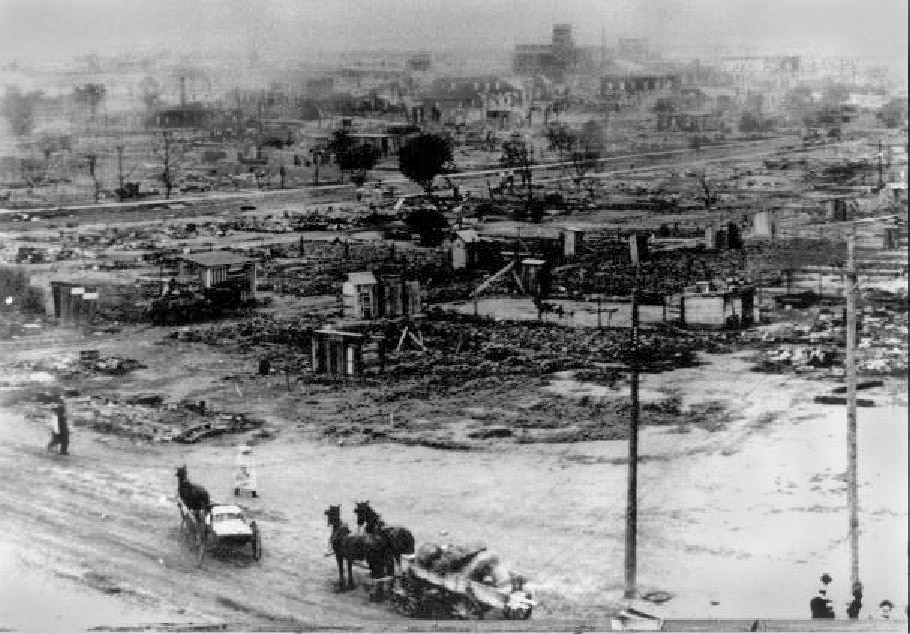Greenwood: The Burning Of Black Wall Street

Ruins of Freemont Street in the affluent black suburb of Greenwood in Tulsa, May of 1921.
In the chapters of American history, there are stories of tragedy and senseless death that are very carefully and almost entirely forgotten. These tales are conveniently forgotten by the wise and craftily ignored by the haughty.
This particular tragedy raged in 1921, in a Tulsa Oklahoma neighborhood that was burned to the ground by a mob. 300 people were officially reported killed. Those killed weren't soldiers or insurrectionists - they were a small community of successful minority business owners who were murdered by a mob of angry white Oklahomans for no better reason than hatred and ignorance.
When the story of Greenwood is foggily recalled it makes Americans, as a people united by common cause, law and geography, question the value of life itself when witnessing that life so carelessly snuffed out. Life snuffed out like stray sparks from an untended fire - crushed under the collective hot boot heel of a blinded, blood-thirsty giant in the guise of justice.
The burning of Greenwood is the record of death stalking the streets in collective form. That form made of everyday men and women who have become bitterly blinded by their own unchecked hatred. In this sense a mob acts as a single mindless giant striking down all in it's path.
In re-telling the story of Greenwood, it's the hope of all historians that this monster will never be able to so easily. To never take to the streets as a force of evil, again. And if and when it does, this blood-thirsty monster will not be ignored or forgotten - but made to face it's own brand of justice in a court of law.
But this is rarely this case. The story of Greenwood, Oklahoma in 1921 is a tragic American story.
I. Greenwood and Black Wall Street
Prior to the turn of the century O.W. Gurley, a wealthy African American land-owner from Arkansas, traveled across the United States to participate in the Oklahoma Land run of 1889. The young entrepreneur had just resigned from a presidential appointment from president Grover Cleveland in order to strike out on his own.
In 1906, Gurley relocated to Tulsa, Oklahoma where he purchased 40 acres of land which was "only to be sold to colored". This notion was unheard of at the time. Gurley's first business in Oklahoma was a rooming house located on a dusty trail near the railroad tracks. This road was called Greenwood Avenue, named for a city in Mississippi. The area became extremely popular amongst African American migrants fleeing Jim Crow and racially based oppression in Mississippi.
Many blacks moved to Oklahoma in the years before and after 1907, which is the year when Oklahoma became a state. Oklahoma must have represented change and provided a chance for African Americans to get away from slavery and the harsh racism of their previous homes. Most of them traveled from the states in the south where racism was very prevalent. To them, Oklahoma offered hope and provided all people with a chance to start over. They traveled to Oklahoma by wagons, horses, trains, and even on foot.
During the oil boom of the 1910's, the area of northeast Oklahoma around Tulsa flourished including the Greenwood neighborhood. Greenwood came to be known as "the Negro Wall Street" now commonly referred to as "the Black Wall Street". The area was home to several prominent black businessmen, many of them multimillionaires. Greenwood contained a variety of thriving businesses that were very successful up until the Tulsa Race Riot.
Not only did African Americans want to contribute to the success of their community but also racial segregation laws prevented them from shopping anywhere else other than Greenwood. Greenwood had the two prerequisites for a successful community: jobs and citizens - citizens who took enormous pride in their neighborhood.
II. Racial Tension
In America, lynchings were acts participated in by angry mobs of white citizens who targeted and jumped upon blacks as scapegoats. These acts were vicious, brutal and violent. American lynchings often culminated in self-righteous murder and Oklahoma was no different.
III. The Fire And Aftermath

The flames raged until it consumed one of the most distinctive and independent communities in America.
Gurley's prominence and wealth were relatively short lived. It matter of moments he lost everything. During the riots The Gurley Hotel at 112 North Greenwood Avenue, the street’s first commercial enterprise, valued at $55,000, was lost, and with it Brunswick Billiard Parlor and Dock Eastmand & Hughes Cafe. Gurley also owned a two-story building at 119 North Greenwood. It housed Carter’s Barbershop, Hardy Rooms, a pool hall, and cigar store. All were reduced to charred ruins. By his own account and court records, he lost nearly $200,000 in the 1921 riots.
Because of his leadership role in creating this self sustaining exclusive black community, it had been rumored that Gurley was lynched by a white mob and buried in an unmarked grave. However, according to the memoirs of Greenwood pioneer B.C. Franklin, My Life and an Era, published in 1997, Gurley had simply exiled himself to California. He died in obscurity a broken man.
References:
Wikipedia, Tulsa Race Riots of 1921
Wikipedia, Greenwood, Oklahoma
Tulsa Reparations Coalition, Tulsa Race Riot Report
Executive Leadership Council, 95 Year Old Survivor Speaks
Before They Die, The Movie



Comments